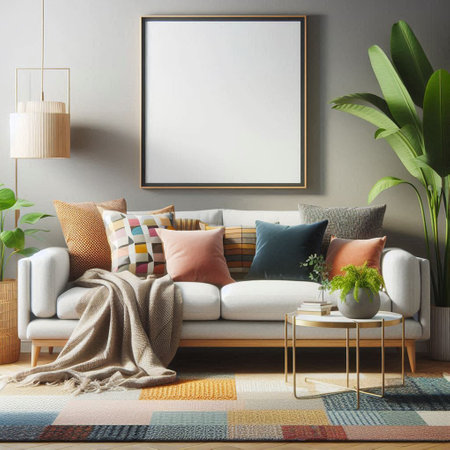Introduction: The Role of Window Treatments in British Homes
Window treatments have long played a pivotal role in shaping the character and comfort of British homes. From the stately sash windows adorned with heavy drapes in Georgian townhouses to the crisp, modern blinds gracing new-build flats, the choice of window coverings reflects not only aesthetic preferences but also cultural values and practical needs. Historically, window dressings in the UK have been influenced by factors such as regional climate, architectural styles, and social customs. For example, thick velvet curtains were once prized in draughty Victorian terraces for their ability to keep out the chill, while delicate lace netting offered privacy without blocking precious natural light in more densely populated urban areas. Today, contemporary lifestyles and advances in technology have broadened the range of available options, allowing homeowners to balance style with considerations like energy efficiency, privacy, and indoor air quality. Whether opting for traditional shutters or embracing sleek roller blinds, Britons continue to use window treatments as a means to express personal taste while responding to the unique demands of their living spaces.
2. Traditional British Window Treatments: Heritage and Function
Traditional window treatments hold a special place in British homes, reflecting both aesthetic tastes and practical needs shaped by the UKs unique climate and architectural history. Among the most iconic are sash windows, wooden shutters, and heavy drapes—each offering distinct advantages in style, privacy, and insulation.
Sash Windows: Timeless Craftsmanship
Sash windows are synonymous with Georgian and Victorian properties across the UK. Characterised by their vertically sliding panels, these windows are typically constructed from robust timbers like pine or oak. Their design allows for effective ventilation while maintaining security and privacy. The craftsmanship involved in original sash windows is highly valued today, making restoration a priority for heritage conservationists.
Materials and Features of Sash Windows
| Feature | Description |
|---|---|
| Material | Pine, Oak, or Accoya wood |
| Glazing | Single or slim-profile double glazing for period accuracy |
| Operation | Cord-and-weight or spring balance systems |
| Heritage Value | Protected under conservation regulations in listed buildings |
Wooden Shutters: Privacy and Energy Efficiency
Wooden shutters have long been a staple in British interiors, particularly in rural cottages and grand townhouses. Traditionally made from hardwoods such as beech or mahogany, these shutters provide adjustable light control and enhance thermal performance during colder months. Their classic panelled look complements period décor while offering increased privacy—a key consideration in densely populated urban areas.
Advantages of Wooden Shutters
- Excellent insulation against drafts and heat loss
- Customisable finishes to match existing joinery
- Add value to heritage properties by preserving original features
Heavy Drapes: Elegance Meets Practicality
No discussion of traditional British window dressings would be complete without mentioning heavy drapes. Often crafted from luxurious materials such as velvet, damask, or wool, these curtains serve both decorative and functional purposes. They help regulate indoor temperatures, block unwanted light, and reduce noise—qualities especially prized during harsh British winters.
Role in Heritage Conservation
The continued use of these traditional solutions plays a vital part in maintaining the authenticity of Britains historic buildings. Not only do they preserve the visual character of period homes, but they also ensure that modern interventions—such as secondary glazing or draught-proofing—can be sympathetically integrated without compromising heritage values.

3. Modern Innovations: Trends and Smart Solutions
In the ever-evolving landscape of British interior design, window treatments have embraced a wave of modern innovation. Homeowners across the UK are increasingly opting for minimalist blinds, which offer a sleek and understated appearance that complements contemporary living spaces. Roller and Venetian blinds in neutral tones have become especially popular, aligning with the trend towards uncluttered aesthetics and providing a practical solution for controlling light and privacy.
Smart window films represent another exciting development. These high-tech films can be applied directly to existing glazing, allowing users to adjust opacity at the touch of a button or even automate changes based on time of day or sunlight levels. Such innovations not only enhance privacy but also contribute to energy efficiency, reflecting the UK’s growing emphasis on sustainable home improvements.
Integrated shading systems are gaining traction in both new builds and renovation projects. These systems seamlessly blend into window frames or recesses, often controlled via smartphone apps or voice assistants such as Alexa or Google Home. This technology-driven approach appeals to tech-savvy Britons keen to streamline their home environments while maintaining an elegant visual profile.
When selecting these modern solutions, it’s important to consider both form and function. Minimalist blinds and smart technologies offer impressive versatility and ease of maintenance—an essential factor for busy households and those conscious of long-term upkeep costs. Additionally, many of these options can be tailored to enhance indoor air quality by reducing dust accumulation compared to traditional fabric curtains, supporting overall household health.
The fusion of innovation, practicality, and British style ensures that today’s window treatments go beyond mere decoration. They provide an integrated approach to managing natural light, privacy, and wellbeing in the modern UK home.
4. Balancing Style and Privacy: Cultural and Practical Considerations
When it comes to window treatments in the UK, style and privacy are deeply influenced by cultural expectations and practical living conditions. The need for privacy is especially pronounced in street-facing living rooms, which are common both in urban terraced housing and rural cottages. However, the approach to achieving this balance can differ significantly between city and countryside.
Urban vs Rural: Navigating Window Treatments
In cities such as London, Manchester, or Birmingham, residential properties often face busy streets with high foot traffic. Urban dwellers typically prioritise privacy without sacrificing natural light—a challenge addressed through layered window treatments. Net curtains or voile panels are a staple, allowing daylight to filter through while shielding interiors from prying eyes. These are often paired with heavier drapes or modern blinds for added insulation and security at night.
Conversely, in rural settings where homes may be more secluded, residents enjoy greater flexibility. Many opt for traditional wooden shutters or simple fabric curtains that highlight rustic charm. Privacy remains important, but the lower density of neighbours means window treatments can lean more towards style than necessity.
Comparison Table: Urban vs Rural Window Treatment Choices
| Aspect | Urban Homes | Rural Homes |
|---|---|---|
| Main Priority | Privacy & Light Control | Aesthetic & Insulation |
| Popular Styles | Nets, Voiles, Roller Blinds, Venetian Blinds | Shutters, Heavy Curtains, Roman Blinds |
| Common Materials | Synthetic Voiles, Metal/Plastic Blinds | Wooden Shutters, Thick Fabrics |
Cultural Influences on Privacy Choices
The British value of home as a private retreat shapes these decisions. In urban environments where anonymity is prized yet hard to achieve, discreet window coverings are essential. Meanwhile, in rural villages where community ties run deep and streets are quieter, windows may be left uncovered during the day—reflecting trust and openness while still providing options for seclusion when needed.
This interplay of culture and practicality ensures that UK residents choose window treatments that not only enhance their home’s appearance but also align with their daily routines and social expectations. Whether it’s maintaining a sense of personal space amid city bustle or embracing tradition in the countryside, balancing style and privacy remains at the heart of British window dressing.
5. Health and Sustainability Considerations
As British homeowners increasingly prioritise sustainability and well-being in their living spaces, window treatments have evolved to play a vital role in supporting both health and eco-friendly objectives. The right choice of blinds, curtains, or shutters can significantly enhance insulation, thereby reducing heat loss during the chilly UK winters and minimising energy consumption year-round.
Insulation and Energy Efficiency
Traditional heavy drapes, especially those lined with thermal fabric, have long been used across the UK to keep draughts at bay and maintain a cosy indoor temperature. Modern innovations such as double-glazed windows paired with fitted blinds or energy-efficient roller shades now offer even greater insulation. This not only helps cut down heating bills but also supports national efforts to reduce carbon emissions, aligning with the UKs commitment to sustainable living.
Air Quality Improvements
Window treatments also influence indoor air quality—a growing concern for health-conscious households. Curtains and blinds made from natural fibres like cotton or linen allow better airflow and are less likely to off-gas volatile organic compounds (VOCs) than synthetic alternatives. Additionally, easy-to-clean options such as wooden shutters or washable roller blinds help control dust mites and allergens, promoting a healthier home environment.
Sustainable Materials and Responsible Choices
There is a noticeable shift towards eco-friendly window coverings crafted from recycled materials or sustainably sourced woods. Brands offering certifications like FSC (Forest Stewardship Council) or OEKO-TEX® Standard 100 are becoming popular choices among British consumers who value both style and environmental responsibility. By selecting these options, homeowners contribute positively to sustainability goals while enjoying the practical benefits of modern window treatments.
6. Maintenance, Longevity, and Professional Care
Regular Care: Keeping Your Window Treatments at Their Best
Whether you’ve opted for the classic charm of wooden shutters or the sleek appeal of modern roller blinds, maintaining your window treatments is essential for both aesthetics and functionality. Dusting regularly with a soft cloth or vacuuming with an upholstery attachment will help prevent build-up on both traditional drapes and contemporary blinds. For fabric curtains and Roman blinds, gentle washing or dry cleaning as per manufacturer instructions can keep colours vibrant and fabrics fresh.
Repair and Upkeep: Addressing Issues Promptly
Inevitable wear and tear occurs over time, especially in busy British households where windows are opened frequently to let in fresh air. Check cords, pulleys, and fixings every few months—replacing frayed strings or tightening loose brackets can extend the life of both traditional sash window dressings and modern Venetian blinds. For timber shutters, keep an eye out for signs of damp or rot, particularly in older properties prone to condensation; a light sand and touch-up paint may be all that’s needed to restore their finish.
Specialist Help: When to Call in the Experts
Some maintenance tasks are best left to professionals. Delicate materials such as silk or wool may require specialist cleaning services to avoid shrinkage or damage. Similarly, if you notice persistent mould or water damage around window frames—common issues in the UK due to high humidity—it’s wise to consult a professional before the problem spreads. Modern electric blinds might need technical support for motor repairs or software updates; don’t attempt electrical work yourself unless you’re fully qualified.
Top Tips for Lasting Window Treatments
- Rotate curtains periodically to ensure even exposure to sunlight and prevent fading.
- Treat wooden elements with appropriate oils or sealants to protect against moisture.
- For allergy sufferers, choose machine-washable fabrics and launder regularly to reduce dust mites.
- Check manufacturer warranties before undertaking any repairs yourself, as DIY fixes may void cover.
Preserving Value and Comfort
By investing a little time into regular maintenance and knowing when to call in a pro, you’ll not only extend the lifespan of your window treatments but also maintain the comfort, privacy, and style that British homes are known for.
7. Conclusion: Choosing the Right Fit for Your Home
When selecting window treatments for your British home, it’s crucial to strike a careful balance between style, privacy, and wellbeing. The wealth of options—ranging from classic curtains and wooden shutters to innovative blinds and smart glass—means there’s a solution tailored for every type of living space found across the UK, whether you reside in a period townhouse or a contemporary flat.
Weighing Up Design and Practicality
Consider the architectural character of your property as well as your interior décor ambitions. Traditional sash windows might be best complemented by heavy drapes or plantation shutters, while minimalist interiors often benefit from the clean lines of roller blinds or discreet Venetians. Always factor in practical aspects such as ease of cleaning, light control, and durability—especially important in high-traffic family homes or rental properties.
Prioritising Health and Wellbeing
Window treatments do more than just add visual appeal—they also play a vital role in supporting comfort and health. Blackout linings can enhance sleep quality, while thermal curtains help reduce draughts and energy bills during chilly British winters. For those with allergies or asthma, opt for hypoallergenic materials and easy-to-clean options like faux wood or washable fabrics.
Personalising Your Space
No two homes are alike, so take time to assess your specific needs. Urban dwellers may prioritise privacy from close neighbours, while rural homeowners might focus on maximising views and natural light. Modular systems or layered treatments (such as combining sheer voiles with heavier curtains) offer flexibility for changing seasons and lifestyles.
Ultimately, the right window treatment is one that harmonises with your home’s unique character while addressing day-to-day living requirements. Take inspiration from both traditional craftsmanship and modern innovations to create spaces that feel secure, comfortable, and distinctly yours.


